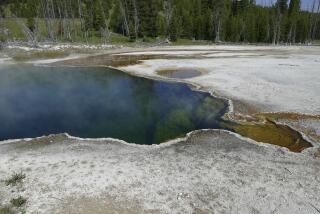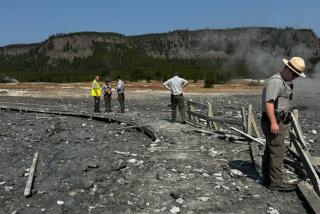SCIENCE / MEDICINE : Meteor Impact Created Yellowstone’s Volcanism, Geology Team Theorizes
- Share via
The famous geysers and hot springs of Yellowstone National Park were created by the impact of a gigantic meteor that struck the Oregon-Nevada border 17 million years ago, Montana researchers said last week.
The impact was so huge that it allowed molten rock from the Earth’s core to flow to the surface, creating a 2-million-year period of intense volcanism that filled the impact crater with lava, geologist Donald W. Hyndman said at a meeting of the Geological Society of America in Tucson.
Similar cataclysmic impacts of meteors in the past have been linked to widespread extinctions of species, such as the death of the dinosaurs 65 million years ago, but scientists have been unable to find the craters that would have been formed by such collisions.
Hyndman and his colleagues argue that researchers have been looking in the wrong places--that they should not be seeking craters but instead large lava formations like that underlying Northern California and states north and east of it.
But their theory is controversial. Geologist Mark Richards of UC Berkeley argued that the Hyndman researchers have not brought forward any new physical evidence to bolster their theory, and they have not developed a plausible mechanism by which such an impact could cause volcanism. He termed their theory “very weak.”
Hyndman, David Alt and James W. Sears argue that a meteorite, perhaps 15 miles in diameter, struck the Earth at a speed of about 15 miles per second. The collision would have carried enough energy to blast a hole more than 90 miles wide and 30 to 45 miles deep. Removal of that much crust would have reduced pressure on underlying hot rock, causing it to melt and flow to the surface and creating the layer of basaltic rock that now underlies the Columbia River Basin.
The collision opened a crack in the Earth’s mantle, Hyndman said, that still allows hot molten rock to escape to the surface. Because the North American tectonic plate has been drifting westward, that hot spot moved eastward, forming the Snake River Basin, until it reached its current location under Yellowstone.
Geologists have generally assumed that similar hot spots are caused by irregularities in the Earth’s crust.






